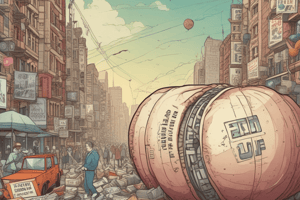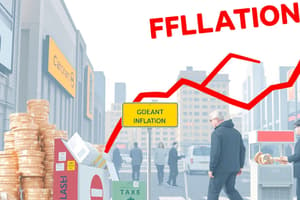Podcast
Questions and Answers
What characterizes demand pull inflation?
What characterizes demand pull inflation?
- Increase in public expenditure by government (correct)
- Decrease in money supply
- Artificial shortage of supply
- Increase in production costs
Which inflation type results from a decrease in production?
Which inflation type results from a decrease in production?
- Structural inflation
- Cost push inflation (correct)
- Demand pull inflation
- Bottleneck inflation
How does deflation affect the purchasing power of currency?
How does deflation affect the purchasing power of currency?
- It increases purchasing power (correct)
- It decreases purchasing power
- It keeps purchasing power stable
- It has no effect on purchasing power
What is a common misconception about stagflation?
What is a common misconception about stagflation?
Which of the following is NOT a factor affecting supply side inflation?
Which of the following is NOT a factor affecting supply side inflation?
What is the primary distinction between headline inflation and core inflation?
What is the primary distinction between headline inflation and core inflation?
Which of the following indices is now used in India to measure headline inflation?
Which of the following indices is now used in India to measure headline inflation?
What does a situation referred to as fiscal drag indicate?
What does a situation referred to as fiscal drag indicate?
How many items are included in the WPI index published in India?
How many items are included in the WPI index published in India?
What is the targeted percentage of inflation by the Indian government?
What is the targeted percentage of inflation by the Indian government?
Flashcards are hidden until you start studying
Study Notes
Understanding Inflation
- Inflation refers to a general rise in prices of most goods and services.
- It denotes an increase in money supply, which reduces the value of money.
- Defined as the rate of price increase over a certain period and reflects the decline in purchasing power of currency.
Types of Inflation
Demand-Pull Inflation
- Also known as demand-driven inflation, occurs when increased demand raises price levels.
- Contributing factors include:
- Increase in money supply
- Rise in income
- Increased government expenditure
- Expansion of the private sector
- Presence of black money
- Deficit financing
- Increased imports
Cost-Push Inflation
- Occurs due to supply shortages which drive prices up.
- Factors include:
- Reduced money supply
- Decline in production
- National calamities
- Artificial supply shortages
- Increased exports
- Rising costs of production
Other Inflation Types
- Demand-Full Inflation: Results from both demand and supply-side issues.
- Cost-Push Inflation: Defined as increased costs of raw materials driving up prices of goods.
- Structural Inflation: Arises from structural problems in the economy.
- Reflation: Price levels rise as the economy recovers from recession.
- Disinflation: Rate of inflation decreases, beneficial in growing economies.
- Deflation: General decline in price levels, allowing consumers to buy more with the same money.
- Bottleneck Inflation: Occurs when supply dramatically drops while demand remains constant.
- Skew Inflation: Price rises in select goods without a broad impact on overall prices.
- Stagflation: High inflation coupled with high unemployment and stagnant economic growth.
- Open Inflation: No government intervention to control inflation.
- Headline Inflation: Total inflation rate in the economy.
- Core Inflation: Rate of inflation excluding volatile food and energy prices.
Inflation Metrics in India
- Wholesale Price Index (WPI) and Consumer Price Index (CPI) are primary measures of inflation.
- WPI measures price changes from the perspective of producers with a focus on wholesale prices; CPI measures prices from the consumer perspective.
- The base year for both WPI and CPI is 2011-12.
- WPI includes 697 items and provides weekly updates; CPI reports monthly and covers urban and rural populations.
Key Components of WPI and CPI
- WPI:
- Three categories: Primary articles, Fuel and Power, Manufactured Goods.
- CPI:
- Consists of goods from daily consumption including food, housing, and fuel.
Monetary Policy and Inflation Management
- The Monetary Policy Committee (MPC) uses CPI data to manage inflation rates.
- Inflation targeting by the Indian government is around 4% with a tolerance range of +/- 2%.
Types of Inflation by Rate
- Creeping Inflation: 1-5% inflation rate, characterized by slow increase.
- Trolling Inflation: 5-10% inflation rate.
- Galloping Inflation: 10-20% inflation rate, known as double-digit inflation.
- Runaway/Hyper Inflation: Rates exceeding 50-100%, leading to severe economic instability.
Additional Concepts
- Inflation Tax: The loss of purchasing power due to rising inflation.
- Inflationary Gap: The difference between current real GDP and potential GDP at full employment.
Studying That Suits You
Use AI to generate personalized quizzes and flashcards to suit your learning preferences.




